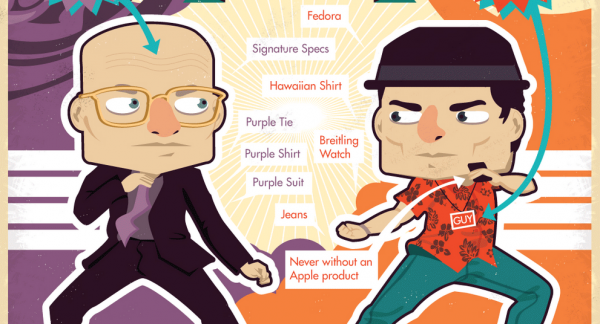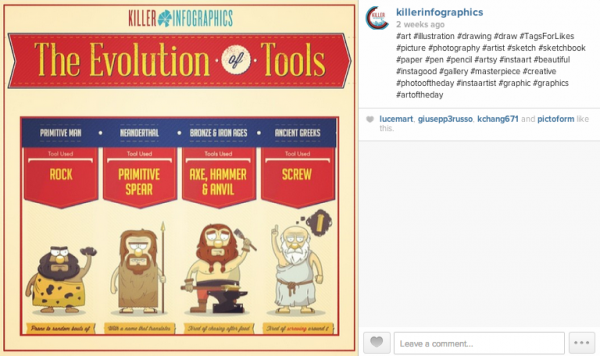Infographics should be a part of any great content marketing strategy because they make complex information easy to digest and are shared widely online with ease. That said, they differ from traditional forms of content in that there are many ways to repurpose a single static infographic to further engage your audience and continue benefitting from your hard work. Below are 5 ways to rinse, reuse and recycle a successful infographic campaign:
1. Turn Your Static Infographic Into a Motion Graphic
In the summer of 2012, my company (Killer Infographics) developed a premium design offering to cater to a higher-end, corporate clientele. To show off this new level of quality, we created an infographic called Seth Godin vs. Guy Kawasaki. We had one marketing goal for the infographic: Get either Seth Godin or Guy Kawasaki to share it. Within a few days, Guy Kawasaki had posted it to his Google+ and Facebook pages, getting us the brand exposure we needed. Soon after, orders for our higher level of design began pouring in. This was a great win for us and one we wanted to continue growing from.
Many months later, we were ready to start pushing another offering: Motion Graphics. To showcase our animation services, we took the same infographic and animated it. It didn't take long for media outlets to write about the animated infographic and for Guy Kawasaki to share it widely again. We wound up doubling our motion graphic team in response to the demand gained by this simple repurposing of a past project.
While this worked quite well for us as a design agency, this could work for any industry. If you want to be a thought leader in your field or show off a great offering or service, first release your message as a static infographic. After a few months, you can then breathe life back into that static design by animating it. This gives you new channels to showcase your work and reignites your original audience in the process.
2. Make Your Static Design Interactive
Today, many consumers are moving away from static and focusing more on interactive experiences. Because of this, clients of all types have come to us asking for an interactive design when their primary goal is to reach an online audience. If you already have a static design that you're proud of, why reinvent the wheel? There are many ways you can make it interactive to share your message further.
For instance, maybe you had to restrict the amount of information included in your static design to ensure your infographic wasn't too wordy. If you make the design interactive, you can include clickable elements that provide the additional information you had to cut the first time.
Adding more information isn't the only reason to make your infographic interactive. Giving your audience a more exciting experience is another simple win you can gain by turning your infographic into an interactive experience. For instance, today parallax scroll infographics are becoming a popular alternative to static design. The static design is used for ease of sharing while the parallax scroll design is used to improve on-site engagement.
3. Create Multiple Social Thumbnails With One Design
Brett Greene, a well known social media expert, once said that every piece of content is a sales person for the rest of your company's life. So if you don't reuse your content, you're stifling your salesforce.
A great infographic design will include multiple segments that can and should be reused throughout your own social media. Create thumbnails for every social media channel to show off your design, call to one important stat, and drive customers back to your website. This is a great way to engage your social media audience and grow your brand.
4. Offer Up Your Infographic to Media
For one year following your infographic's release, setup a Google Alert and a HARO alert for any keywords related to your infographic topic. If a reporter writes about the topic or is looking for information that your infographic helps to shed light on, offer them your infographic for free. This is a great way to revive an infographic from months past and get brand recognition in major publications.
5. Convert Your Web-based Design to a Printed Piece
The long-scroll, vertical infographic design is typical when creating something for online sharing. It's far easier to share a design that is made to fit cleanly in a blog post. That said, infographics are no longer just a digital medium. In fact, they are being used more and more offline as a great tool to connect with customers face to face. If you have an infographic you love, print it as a backdrop to your company's booth at a conference. Maybe you want something you can hand out to customers instead. If so, ask the original designer to re-design the infographic to meet any necessary print dimensions. They may have to take some information out to fit everything into a smaller space, but it would still give you a great sales leave behind to drive customers to your website or storefront.
Unlike traditional content, infographics provide continuous opportunities for brand exposure and customer acquisition. When choosing to start an infographic campaign, always consider every potential way you can use that design in the future to get the biggest bang for your buck!



